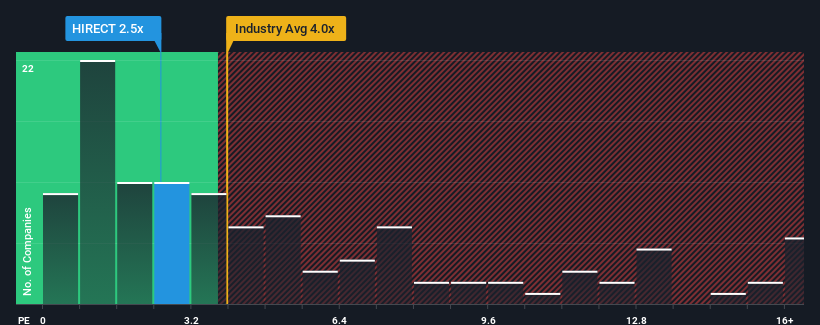- India
- /
- Electrical
- /
- NSEI:HIRECT
There's No Escaping Hind Rectifiers Limited's (NSE:HIRECT) Muted Revenues
You may think that with a price-to-sales (or "P/S") ratio of 2.5x Hind Rectifiers Limited (NSE:HIRECT) is a stock worth checking out, seeing as almost half of all the Electrical companies in India have P/S ratios greater than 4x and even P/S higher than 8x aren't out of the ordinary. Nonetheless, we'd need to dig a little deeper to determine if there is a rational basis for the reduced P/S.
See our latest analysis for Hind Rectifiers

What Does Hind Rectifiers' P/S Mean For Shareholders?
Hind Rectifiers certainly has been doing a great job lately as it's been growing its revenue at a really rapid pace. It might be that many expect the strong revenue performance to degrade substantially, which has repressed the P/S ratio. If that doesn't eventuate, then existing shareholders have reason to be quite optimistic about the future direction of the share price.
Although there are no analyst estimates available for Hind Rectifiers, take a look at this free data-rich visualisation to see how the company stacks up on earnings, revenue and cash flow.Is There Any Revenue Growth Forecasted For Hind Rectifiers?
There's an inherent assumption that a company should underperform the industry for P/S ratios like Hind Rectifiers' to be considered reasonable.
Retrospectively, the last year delivered an exceptional 44% gain to the company's top line. Pleasingly, revenue has also lifted 70% in aggregate from three years ago, thanks to the last 12 months of growth. So we can start by confirming that the company has done a great job of growing revenue over that time.
Comparing that to the industry, which is predicted to deliver 33% growth in the next 12 months, the company's momentum is weaker, based on recent medium-term annualised revenue results.
With this information, we can see why Hind Rectifiers is trading at a P/S lower than the industry. Apparently many shareholders weren't comfortable holding on to something they believe will continue to trail the wider industry.
The Bottom Line On Hind Rectifiers' P/S
While the price-to-sales ratio shouldn't be the defining factor in whether you buy a stock or not, it's quite a capable barometer of revenue expectations.
Our examination of Hind Rectifiers confirms that the company's revenue trends over the past three-year years are a key factor in its low price-to-sales ratio, as we suspected, given they fall short of current industry expectations. At this stage investors feel the potential for an improvement in revenue isn't great enough to justify a higher P/S ratio. Unless the recent medium-term conditions improve, they will continue to form a barrier for the share price around these levels.
You should always think about risks. Case in point, we've spotted 3 warning signs for Hind Rectifiers you should be aware of, and 1 of them is significant.
If you're unsure about the strength of Hind Rectifiers' business, why not explore our interactive list of stocks with solid business fundamentals for some other companies you may have missed.
Valuation is complex, but we're here to simplify it.
Discover if Hind Rectifiers might be undervalued or overvalued with our detailed analysis, featuring fair value estimates, potential risks, dividends, insider trades, and its financial condition.
Access Free AnalysisHave feedback on this article? Concerned about the content? Get in touch with us directly. Alternatively, email editorial-team (at) simplywallst.com.
This article by Simply Wall St is general in nature. We provide commentary based on historical data and analyst forecasts only using an unbiased methodology and our articles are not intended to be financial advice. It does not constitute a recommendation to buy or sell any stock, and does not take account of your objectives, or your financial situation. We aim to bring you long-term focused analysis driven by fundamental data. Note that our analysis may not factor in the latest price-sensitive company announcements or qualitative material. Simply Wall St has no position in any stocks mentioned.
Have feedback on this article? Concerned about the content? Get in touch with us directly. Alternatively, email editorial-team@simplywallst.com
About NSEI:HIRECT
Hind Rectifiers
Designs, develops, manufactures, and markets power semiconductors, power electronic equipment, and railway transportation equipment in India and internationally.
Solid track record with adequate balance sheet.
Market Insights
Community Narratives



